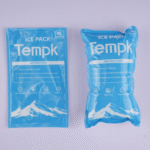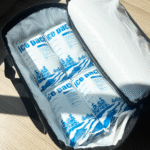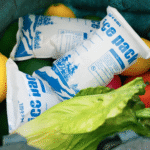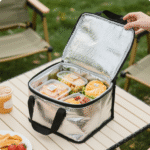Dry Ice Packs for Shipping Ice Cream: 2025 Guide
If you sell frozen treats, you need dry ice packs for shipping ice cream that keep product rock‑solid and compliant—without wasting weight or risking fines. Below you’ll get exact starting amounts, a simple packout, and the current 2025 rules in plain English. Expect net‑weight labeling, a 200 kg per‑package air limit, and a USPS 5 lb cap for domestic air mail.
-
How many dry ice packs for shipping ice cream do you really need (24–72 hours)?
-
What labels, marks, and documents keep you IATA/USPS/DOT compliant in 2025?
-
When should you choose −21 °C PCM packs instead of dry ice for shipping ice cream?
-
Which insulated liners work best (EPS, VIPs, or curbside‑recyclable paper)?
-
How to reduce coolant cost and still pass ISTA 7E profiles?
How many dry ice packs for shipping ice cream do you need?
Start here: 8–10 lb (3.6–4.5 kg) for 24–48 h; 18–25 lb (8–11 kg) for ~72 h; ~35 lb (16 kg) for ~96 h in a well‑insulated shipper with venting. Use more for bigger boxes, summer lanes, or frequent door‑opens. These ranges consolidate lab tests across common 10–20 qt shippers.
Why these ranges work. Ice cream wants ≤−12 °C. Dry ice sits at −78.5 °C and sublimates, buffering heat as it vents. Your lane’s thermal load is “ambient profile × time × box U‑value.” If you validate against ISTA 7E parcel profiles, these starting amounts land close, then you trim by test.
Quick calculator for dry ice packs for shipping ice cream
Rule‑of‑thumb estimate (then validate):
-
Start with 0.25–0.35 lb dry ice per pint per 24 h.
-
Add 10–20% for summer lanes or low‑density boxes.
-
Add 10% if you hand off to carriers late day (more time off‑dock).
| Packout Example | Duration | Starting Dry Ice | What it means for you |
|---|---|---|---|
| 4 pints in 10 qt EPS | 24 h | 6–8 lb | Fits USPS air cap only if ≤5 lb: choose ground or reduce payload. |
| 8 pints in 14 qt EPS | 48 h | 10–14 lb | Typical 2‑day DTC; validate on ISTA 7E Hot. |
| 12 pints in 20 qt EPS | 72 h | 18–25 lb | Add spacer to avoid freeze‑burn on top pints. |
Practical tips
-
Stage pints cold (≤−18 °C) before packout; warm product eats coolant fast.
-
Vent the lid; never seal dry ice in airtight packaging. DOT requires venting.
-
Weigh dry ice in kilograms and write it on the box; carriers check.
Real‑world case: A 20″ cube shipper with 3″ EPS, 12 pints, and 35 lb dry ice held below −12 °C for ~96 h on a hot‑profile test; 72 h was achieved at ~25 lb.
How do you label and ship dry ice packs for shipping ice cream legally in 2025?
Do this every time: Mark “UN1845, Dry Ice,” add net dry ice in kg, apply the Class 9 diamond, and vent the package. On the airwaybill, list UN1845, the proper name, number of packages, and the net weight per package. The IATA 2025 checklist caps each package at 200 kg.
Mailing with USPS? For domestic air (Priority Mail, etc.), ≤5 lb per mailpiece; surface mail can exceed 5 lb with proper venting and marks. International USPS prohibits dry ice.
U.S. DOT (49 CFR) reminders: Outer packaging must allow CO₂ to escape; vessel and aircraft rules add special dry‑ice marks and stowage conditions. Passenger baggage is limited to 2.5 kg with operator approval—not for commerce.
Marking & venting checklist
-
Class 9 label and the proper shipping name on the same surface when size allows.
-
Net dry ice in kilograms outside the hazard label border.
-
Nature & Quantity of Goods (AWB): UN1845; “Dry Ice”; package count × kg each.
When should you use −21 °C PCM packs instead of dry ice packs for shipping ice cream?
Use −21 °C PCMs when you want frozen control without hazmat paperwork or when carriers or destinations restrict dry ice. Modern PCM bricks hold −21 °C through their phase change but must be preconditioned (deep‑frozen) before use. Expect slightly higher packout mass than dry ice for long lanes, but easier handling and no CO₂ venting.
How to precondition PCMs
Freeze bricks flat to at or below their phase‑change point; vendors specify the exact setpoint and time (e.g., 24–48 h). For some systems, a −40 °C or colder freezer improves charge; always follow the supplier’s guide.
| Refrigerant | Nominal Temp | Handling | What it means for you |
|---|---|---|---|
| Dry ice (CO₂) | −78.5 °C | Hazmat marks; vented shipper; net‑kg label | Best for long lanes; strict labeling. |
| PCM bricks | −21 °C | Deep‑freeze precharge; no hazmat | Cleaner receiving; good for air lanes with restrictions. |
| Water gel packs | 0 °C | Simple freeze; not frozen control | For chilled, not ice cream. |
Which insulation works best for dry ice packs for shipping ice cream?
EPS (foam coolers) is cost‑effective and widely used. VIPs (vacuum panels) cut coolant mass but raise cost. Paper‑based curbside‑recyclable liners now claim up to 72 h performance with the right packout—popular for DTC brands aiming at sustainability. Validate against ISTA 7E before rollout.
Buyer’s table
| Liner type | Typical R/performance | Notes | Impact for you |
|---|---|---|---|
| EPS 1–3″ | 24–72 h with adequate dry ice | Bulky, cheap, reliable | Lowest cost per order; bigger boxes |
| VIP hybrid | 72–120 h with less coolant | Fragile, expensive | Shrinks box/coolant; higher unit cost |
| Paper liners | Up to 72 h (vendor‑validated) | 100% curbside‑recyclable options | Improves unboxing & sustainability story |
Safety you shouldn’t skip
CO₂ exposure limits: OSHA/NIOSH TWA 5,000 ppm; STEL 30,000 ppm; IDLH 40,000 ppm. Vent your staging area, keep boxes out of enclosed cars, and train staff.
2025 updates shaping dry ice packs for shipping ice cream
Regulatory: The FDA proposed moving FSMA 204 traceability compliance to July 20, 2028. Plan your lot‑level data capture now; the requirements don’t change—only the date.
Materials & sustainability: The FDA confirms PFAS‑based grease‑proofers are no longer sold for paper food contact uses in the U.S. Consider liners and wraps that meet the new reality.
Market tailwinds: U.S. frozen foods are growing; research pegs the U.S. market near $90 B in 2025 with strong CAGR through 2030—supporting DTC frozen programs.
At‑a‑glance
-
200 kg/package IATA limit for dry ice remains in force.
-
USPS air cap 5 lb per mailpiece; surface can exceed with proper marks.
-
Paper liners marketed with up to 72 h protection; validate on ISTA 7E.
Market insight: More brands are swapping EPS for curbside‑recyclable liners to reduce customer friction and chargebacks tied to disposal. Test a hybrid (paper + VIP corners) before a full switch.
FAQs
How much dry ice packs for shipping ice cream do I need for 2 days?
Start around 10–14 lb for 8 pints in a mid‑size EPS shipper; confirm with a lane test.
Can I ship dry ice with USPS?
Yes—≤5 lb per domestic air mailpiece with venting and marks; more is allowed via surface. No international USPS dry ice.
What must be on the box for air?
“UN1845 Dry Ice,” net kg of dry ice, Class 9 diamond, and venting. Put UN, name, and label on the same face when size allows.
Do I need an airwaybill entry?
Yes—UN1845, proper name, number of packages, and net kg each.
Are −21 °C PCM packs a legal alternative?
Yes; they’re not hazmat, but you must precondition them properly per the vendor’s guide.
Summary & next steps
Key points: Use validated ranges for dry ice packs for shipping ice cream, label per IATA PI 954, and vent every box. Consider −21 °C PCM when hazmat handling slows you down, and test paper liners if you need a curbside‑recyclable story.
Do this now:
-
Pick your lane profile and run an ISTA 7E chamber test.
-
Set a starter coolant table and SOP.
-
Audit labels and AWB entries for UN1845/net‑kg.
-
Pilot paper liners on low‑risk lanes.
About Tempk
We design thermal systems for food and life‑science shippers, with validated packouts across EPS, VIP, and curbside‑recyclable paper. Our tools cut coolant overfill and lower DIM weight without sacrificing hold time. We back every recommendation with test data and training.
Talk to an engineer: Configure your packout or book a same‑day validation slot.
























